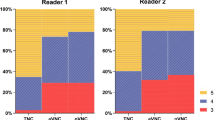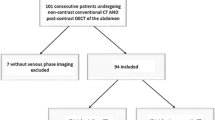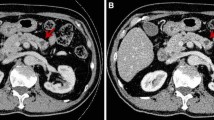Abstract
Purpose
To evaluate the quantitative attenuation and reliability of virtual non-contrast (VNC) images of the abdomen acquired from multiphasic scans with a dual-energy computed tomography (DECT) system and compare it with that of true non-enhanced images (TNC) on second- (Flash) and third- (Force) generation DECT scanners.
Methods
This retrospective study was approved by the institutional review board and included 123 patients with pancreatic cancer who had undergone routine clinical multiphasic DECT examinations at our institution using Flash and Force scanners between March and August 2017. VNC images of the abdomen were reconstructed from late arterial phase images. For every patient, regions-of-interest were defined in the aorta, fluid-containing structures (gallbladder, pleural effusion, and renal cysts > 10 mm), paravertebral muscles, subcutaneous fat, spleen, pancreas, renal cortex, and liver (eight locations) on TNC and VNC images. The mean attenuation of VNC was compared with TNC by organ for each CT scanner using an equivalence test and the Bland–Altman plot. The mean attenuations for TNC or VNC were compared between the Force and Flash CT scanners using a two-sample t test.
Results
The VNC attenuation of organs on the Force scanner was lower than was that on the Flash, and the mean attenuation difference in different organs on the Force was closer to 0. The estimated means of TNC and VNC were equivalent for an equivalence margin of 10 on the Force scanner.
Conclusion
VNC images in DECT are a promising alternative to TNC images. In clinical scenarios in which non-enhanced CT images are required but are not available for accurate diagnosis, VNC images can potentially serve as an alternative to TNC images without the radiation exposure risks.





Similar content being viewed by others
References
Alvarez RE, Macovski A (1976) Energy-selective reconstructions in X-ray computerized tomography. Phys Med Biol 21 (5):733–744
Mileto A, Marin D, Alfaro-Cordoba M, Ramirez-Giraldo JC, Eusemann CD, Scribano E, Blandino A, Mazziotti S, Ascenti G (2014) Iodine quantification to distinguish clear cell from papillary renal cell carcinoma at dual-energy multidetector CT: a multireader diagnostic performance study. Radiology 273 (3):813–820. https://doi.org/10.1148/radiol.14140171
Manoharan D, Sharma S, Das CJ, Kumar R, Singh G, Kumar P (2018) Single-Acquisition Triple-Bolus Dual-Energy CT Protocol for Comprehensive Evaluation of Renal Masses: A Single-Center Randomized Noninferiority Trial. AJR Am J Roentgenol 211 (1):W22–W32. https://doi.org/10.2214/ajr.17.18786
Kim SH, Kim CS, Kim MJ, Cho JY, Cho SH (2016) Differentiation of Clear Cell Renal Cell Carcinoma From Other Subtypes and Fat-Poor Angiomyolipoma by Use of Quantitative Enhancement Measurement During Three-Phase MDCT. AJR Am J Roentgenol 206 (1):W21–28. https://doi.org/10.2214/ajr.15.14666
Mileto A, Marin D, Ramirez-Giraldo JC, Scribano E, Krauss B, Mazziotti S, Ascenti G (2014) Accuracy of contrast-enhanced dual-energy MDCT for the assessment of iodine uptake in renal lesions. AJR American journal of roentgenology 202 (5):W466–474. https://doi.org/10.2214/ajr.13.11450
Chandarana H, Megibow AJ, Cohen BA, Srinivasan R, Kim D, Leidecker C, Macari M (2011) Iodine quantification with dual-energy CT: phantom study and preliminary experience with renal masses. AJR American journal of roentgenology 196 (6):W693–700. https://doi.org/10.2214/ajr.10.5541
Frellesen C, Azadegan M, Martin SS, Otani K, D’Angelo T, Booz C, Eichler K, Panahi B, Kaup M, Bauer RW, Vogl TJ, Wichmann JL (2018) Dual-Energy Computed Tomography-Based Display of Bone Marrow Edema in Incidental Vertebral Compression Fractures: Diagnostic Accuracy and Characterization in Oncological Patients Undergoing Routine Staging Computed Tomography. Invest Radiol 53 (7):409–416. https://doi.org/10.1097/rli.0000000000000458
Graser A, Johnson TR, Bader M, Staehler M, Haseke N, Nikolaou K, Reiser MF, Stief CG, Becker CR (2008) Dual energy CT characterization of urinary calculi: initial in vitro and clinical experience. Invest Radiol 43 (2):112–119. https://doi.org/10.1097/rli.0b013e318157a144
Takahashi N, Vrtiska TJ, Kawashima A, Hartman RP, Primak AN, Fletcher JG, McCollough CH (2010) Detectability of urinary stones on virtual nonenhanced images generated at pyelographic-phase dual-energy CT. Radiology 256 (1):184–190. https://doi.org/10.1148/radiol.10091411
Phan CM, Yoo AJ, Hirsch JA, Nogueira RG, Gupta R (2012) Differentiation of hemorrhage from iodinated contrast in different intracranial compartments using dual-energy head CT. AJNR Am J Neuroradiol 33 (6):1088–1094. https://doi.org/10.3174/ajnr.a2909
De Cecco CN, Muscogiuri G, Schoepf UJ, Caruso D, Wichmann JL, Cannaò PM, Canstein C, Fuller SR, Snider L, Varga-Szemes A, Hardie A (2016) Virtual unenhanced imaging of the liver with third-generation dual-source dual-energy CT and advanced modeled iterative reconstruction. Eur J Radiol 85 (7):1257–1264. https://doi.org/10.1016/j.ejrad.2016.04.012
De Cecco CN, Darnell A, Macías N, Ayuso JR, Rodríguez S, Rimola J, Pagés M, García-Criado Á, Rengo M, Laghi A, Ayuso C (2013) Virtual Unenhanced Images of the Abdomen With Second-Generation Dual-Source Dual-Energy Computed Tomography: Image Quality and Liver Lesion Detection. Invest Radiol 48 (1):1–9. https://doi.org/10.1097/rli.0b013e31826e7902
Bosniak MA (1986) The current radiological approach to renal cysts. Radiology 158 (1):1–10. https://doi.org/10.1148/radiology.158.1.3510019
Sauter AP, Kopp FK, Munzel D, Dangelmaier J, Renz M, Renger B, Braren R, Fingerle AA, Rummeny EJ, Noel PB (2018) Accuracy of iodine quantification in dual-layer spectral CT: Influence of iterative reconstruction, patient habitus and tube parameters. Eur J Radiol 102:83–88. https://doi.org/10.1016/j.ejrad.2018.03.009
Sauter AP, Muenzel D, Dangelmaier J, Braren R, Pfeiffer F, Rummeny EJ, Noel PB, Fingerle AA (2018) Dual-layer spectral computed tomography: Virtual non-contrast in comparison to true non-contrast images. Eur J Radiol 104:108–114. https://doi.org/10.1016/j.ejrad.2018.05.007
Ananthakrishnan L, Rajiah P, Ahn R, Rassouli N, Xi Y, Soesbe TC, Lewis MA, Lenkinski RE, Leyendecker JR, Abbara S (2017) Spectral detector CT-derived virtual non-contrast images: comparison of attenuation values with unenhanced CT. Abdom Radiol (NY) 42 (3):702–709. https://doi.org/10.1007/s00261-016-1036-9
Toepker M, Moritz T, Krauss B, Weber M, Euller G, Mang T, Wolf F, Herold CJ, Ringl H (2012) Virtual non-contrast in second-generation, dual-energy computed tomography: Reliability of attenuation values. Eur J Radiol 81 (3):e398–e405. https://doi.org/10.1016/j.ejrad.2011.12.011
Kaufmann SMD, Sauter AMD, Spira DMD, Gatidis SMD, Ketelsen DMD, Heuschmid MMD, Claussen CDMD, Thomas CMD (2013) Tin-filter Enhanced Dual-Energy-CT. Acad Radiol 20 (5):596–603. https://doi.org/10.1016/j.acra.2013.01.010
Barrett T, Bowden DJ, Shaida N, Godfrey EM, Taylor A, Lomas DJ, Shaw AS (2011) Virtual unenhanced second generation dual-source CT of the liver: Is it time to discard the conventional unenhanced phase? Eur J Radiol 81 (7):1438–1445. https://doi.org/10.1016/j.ejrad.2011.03.042
Acknowledgement
Special thanks to the Department of Scientific Publications at The University of Texas MD Anderson Cancer Center for their help in editing the manuscript.
Author information
Authors and Affiliations
Corresponding author
Ethics declarations
Conflict of interest
Rick Layman has received Siemens Healthineers and USDA SBIR grant.
Informed Consent
Institutional review board authorization was obtained. Formal consent was waived for this retrospective study.
Additional information
Publisher's Note
Springer Nature remains neutral with regard to jurisdictional claims in published maps and institutional affiliations.
Rights and permissions
About this article
Cite this article
Javadi, S., Elsherif, S., Bhosale, P. et al. Quantitative attenuation accuracy of virtual non-enhanced imaging compared to that of true non-enhanced imaging on dual-source dual-energy CT. Abdom Radiol 45, 1100–1109 (2020). https://doi.org/10.1007/s00261-020-02415-8
Published:
Issue Date:
DOI: https://doi.org/10.1007/s00261-020-02415-8




